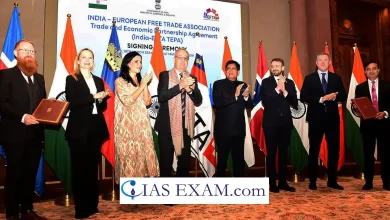Overhaul of India-Nepal Relationship
[GS Paper 2 – Bilateral Relations, Regional and Global Groupings and Agreements involving India]
Recent visit of Prime Minister of Nepal, Mr. Sher Bahadur Debua brings an opportunity to repair the India-Nepal Relationship and restore it back to its heights.
The Nepal Prime Minister, Sher Bahadur Deuba, paid a long-awaited visit to India last week (April 1-3). Sworn in in July 2021, this was his first bilateral visit abroad, in keeping with tradition.
Key Developments during the Visit
- Operationalization of a 35km cross border rail link from Jayanagar (Bihar) to Kurtha (Nepal). Two further phases will extend it to Bijalpura and Bardibas.
- Konkan Railway Corporation will provide the necessary technical support initially.
- 90 km long 132 kV double circuit transmission line connecting Tila (Solukhumbu) to Mirchaiya (Siraha) close to the Indian border.
- More than a dozen hydroelectric projects planned to be setup in the Solu corridor for which the Nepal Electricity Authority has concluded PPAs of 325 MW.
- Agreements providing technical cooperation in the railway sector, Nepal’s induction into the International Solar Alliance, and between Indian Oil Corporation and Nepal Oil Corporation on ensuring regular supplies of petroleum products were also signed.
- Joint Vision Statement on power sector cooperation which recognises the opportunities for joint development power generation projects together with cross border transmission linkages and coordination between the national grids.
- Together with the Pancheshwar project the Millennium Challenge Corporation provides welcome synergy to the hydroelectric potential of Nepal.
Challenges associated with India-Nepal Relations
Over the years, a number of differences have emerged between India and Nepal that need attention.
- The relationship took a nosedive in 2015, with India first getting blamed for interfering in the Constitution drafting process and then for an “unofficial blockade” that generated widespread resentment against India.
- Border Disputes – The issue erupted in November 2019 when Nepal had released a new political map that claims Kalapani, Limpiyadhura and Lipulekh of Uttarakhand as part of Nepal’s territory. The area of Susta (West Champaran district, Bihar) can also be noted in the new map.
- Kalapani boundary issue – These boundaries had been fixed in 1816 by the British, and India inherited the areas over which the British had exercised territorial control in 1947. While 98% of the India-Nepal boundary was demarcated, two areas, Susta and Kalapani remained in limbo.
- Chinese Influence – As a landlocked nation, Nepal depended for many years on Indian imports, and India played an active role in Nepal’s affairs. However, in recent years, Nepal has drifted away from India’s influence, and China has gradually filled the space with investments, aid and loans.
- China considers Nepal a key partner in its Belt and Road Initiative (BRI), and wants to invest in Nepal’s infrastructure as part of its grand plans to boost global trade. Rising Nepal and China cooperation can undermine Nepal’s distinction of buffer state between India and China.
- Treaty of Peace and Friendship – As one of the oldest bonds, the 1950 Treaty of Peace and Friendship was originally sought by the Nepali authorities in 1949 to continue the special links they had with British India. It provides for an open border and for Nepali nationals to have the right to work in India. But today, it is viewed as a sign of an unequal relationship, and an Indian imposition.
Way Forward
India should negotiate diplomatically to resolve the boundary dispute with Nepal under the aegis of International law on Trans-boundary Water Disputes. In this case, boundary dispute resolution between India and Bangladesh should serve as a model.
India should engage more proactively with Nepal in terms of people to people engagement, bureaucratic engagement as well as political interactions. Mere differences shall not turn into disputes and both the countries should resolve the issues peacefully.





.png)



